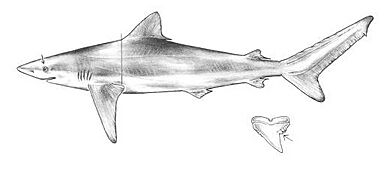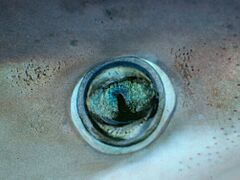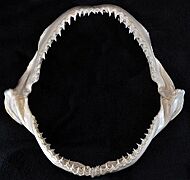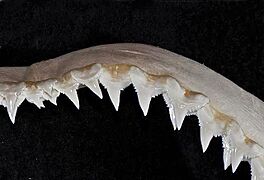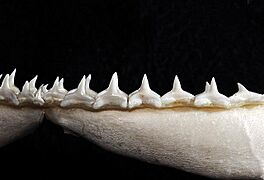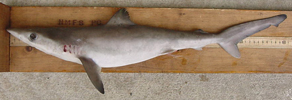Night shark facts for kids
Quick facts for kids Night shark |
|
|---|---|
 |
|
| Conservation status | |
| Scientific classification | |
 |
|
| Range of the night shark | |
| Synonyms | |
|
Hypoprion bigelowi Cadenat, 1956 |
The night shark (Carcharhinus signatus) is a type of requiem shark. These sharks live in the Atlantic Ocean, in both warm and mild waters. They usually stay near the edge of the continental shelf and the upper continental slope. This means they live in deeper waters, typically between 50 to 600 meters (160 to 2,000 feet) deep.
Night sharks are known for their daily vertical migration. They spend their days in deeper water and move closer to the surface at night. Off the coast of northeastern Brazil, many night sharks gather around underwater mountains called seamounts. This shark has a slim body and can grow up to 2 meters (6.6 feet) long. You can spot them by their long, pointed snout and large, green eyes when they are alive. They are dark grayish-blue or brown on top and white underneath.
Night sharks are fast and hunt at night, often swimming in schools. They mainly eat small bony fishes and squid. Like other sharks in their family, they give birth to live young. Females usually mate in the summer and have 12 to 18 pups after about a year. These deepwater sharks are not known to be dangerous to humans.
However, night sharks are sometimes caught by accident by fishing boats that hunt tuna and swordfish. There is also a specific fishery off northeastern Brazil that targets them. Night sharks are valued for their fins, meat, liver oil, and fishmeal. Sadly, many sharks caught off northeastern Brazil have high levels of mercury, which can be harmful. Because they reproduce slowly and their numbers have dropped in places like the Caribbean, the night shark is considered a vulnerable species.
Contents
Understanding the Night Shark
What is a Night Shark?
The first scientific description of the night shark was written by Cuban zoologist Felipe Poey in 1868. He named it Hypoprion signatus based on a set of jaws. Later, in 1973, another scientist, Leonard Compagno, grouped Hypoprion with the Carcharhinus genus. The shark got its common name, "night shark," because it is mostly caught at night. This suggests it is more active after dark.
Where Do Night Sharks Live?
Night sharks live in the Atlantic Ocean. Their range stretches from U.S. state of Massachusetts down to Argentina in the west. This includes the Gulf of Mexico and the Caribbean Sea. In the east, they are found from Senegal to northern Namibia off the coast of Africa. In the United States, they are more common near North Carolina and Florida.
These sharks prefer deep water. They have been seen as deep as 2 kilometers (1.2 miles), but they sometimes come closer to the surface, as shallow as 26 meters (85 feet). Off the southeastern United States, they are usually found between 50 and 600 meters (160 to 2,000 feet) deep. Near northeastern Brazil, they often live near the tops of underwater mountains, at depths from 38 to 370 meters (125 to 1,214 feet).
Night Shark Appearance
The night shark has a sleek body and a long, pointed snout. Its nostrils have small flaps of skin. The eyes are large, round, and green when the shark is alive. They also have a special protective third eyelid called a nictitating membrane.
The mouth has about 15 rows of teeth on each side of both the upper and lower jaws. The upper teeth are narrow and have jagged edges, while the lower teeth are smooth and stand upright. The shark has five short gill slits on each side of its head.
Its pectoral fins are short and rounded. The first dorsal fin is small and triangular, starting above the pectoral fins. The second dorsal fin is much smaller and is located above the anal fin. There is a ridge of skin between the two dorsal fins. The shark's skin feels rough because it is covered in tiny, diamond-shaped scales called dermal denticles. These denticles have ridges that increase in number as the shark gets older.
Night sharks are grayish-blue or brown on top and white underneath. They do not have any special markings on their fins. Sometimes, they have a faint band on each side and small black spots on their back. Most night sharks grow to about 2.0 meters (6.6 feet) long. The largest recorded night shark was 2.8 meters (9.2 feet) long and weighed 76.7 kilograms (169 pounds).
Night Shark Life Cycle
Diet and Behavior
Night sharks are fast and full of energy. They mostly eat small, active bony fishes like mullet, mackerel, butterfish, sea basses, and flyingfish. They also sometimes eat squid and shrimp. Most of their hunting happens at night, which is why they are called "night sharks." They are most active around dawn and dusk.
These sharks usually swim in schools. They perform a daily vertical migration, meaning they spend the day in deeper waters (around 275 to 366 meters or 900 to 1,200 feet) and move up to shallower waters (less than 183 meters or 600 feet) at night. Larger sharks might hunt night sharks. Some small creatures called copepods and tapeworms can live on or inside night sharks as parasites. The common remora fish sometimes attaches itself to night sharks.
Reproduction and Growth
Like other sharks in their family, night sharks are viviparous. This means the mother carries the developing embryos inside her body. The embryos get food from a special connection called a placenta, similar to how mammals develop. Female night sharks have one working ovary and two working uteri. Each uterus is divided into sections for each embryo.
Most of what we know about night shark reproduction comes from sharks off northeastern Brazil. In this area, sharks mate during the summer. After about a year, females give birth to four to 18 pups, but usually 12 or more. Young sharks are born measuring between 50 and 72 centimeters (20 to 28 inches) long.
They grow very quickly in their first year, adding about 25 centimeters (10 inches) to their length. This fast growth helps them become less vulnerable to predators when they are small. As they get older, their growth slows down to about 8.6 centimeters (3.4 inches) per year. Male night sharks become mature when they are about 1.8 to 1.9 meters (5.9 to 6.2 feet) long, around 8 years old. Females mature at 2.0 to 2.1 meters (6.6 to 6.9 feet) long, around 10 years old. The oldest known night sharks lived to be 17 years old, but scientists estimate they can live up to 28 years for males and 30 years for females.
Night Sharks and Humans
Fishing and Conservation Concerns
Because night sharks live in deep water, they are not usually a threat to humans. However, their large fins are highly valued for shark fin soup. Their meat, liver oil, and fishmeal are also used. Historically, night sharks were often caught by accident by fishing boats targeting swordfish and tuna in the western Atlantic. Since 1991, there has been a specific fishery off northeastern Brazil that targets night sharks because many of them gather around underwater mountains there. About 90% of the sharks and rays caught in this area are night sharks, and most of them are young sharks.
A study found that night sharks from northeastern Brazil have high levels of mercury in their bodies. This is likely because of the fish they eat. About 92% of the sharks tested had mercury levels higher than what is considered safe by the Brazilian government for fish meant for eating. The average mercury level was 1.742 milligrams per kilogram. This means that eating even a small amount of night shark meat every day could lead to consuming too much mercury, according to the World Health Organization.
The International Union for Conservation of Nature (IUCN) has listed the night shark as Endangered globally. This is because they reproduce slowly and their numbers have dropped due to fishing. The American Fisheries Society also lists them as vulnerable. Night sharks used to be a big part of the Cuban shark fishery from 1937 to 1941, making up 60-75% of the catch. However, their numbers greatly decreased in the 1970s. A similar drop was seen in catches by U.S. fisheries and fishing tournaments. The intense fishing off Brazil is a major concern, even though some fishing efforts are now shifting to swordfish and bigeye tuna.
Protecting Night Sharks
In 1997, the U.S. National Oceanographic and Atmospheric Administration (NOAA) listed the night shark as a "Species of Concern." This means it needs attention for conservation, but there wasn't enough evidence to list it under the Endangered Species Act. In 1999, new rules were made to stop keeping 19 shark species, including the night shark, when caught by U.S. fishing boats. This rule was kept in 2003.
Even with these rules, many night sharks caught by accident on longlines still die. Some fishers might also keep them because they are valuable and hard to identify when only parts are left. However, a 2003-2008 study by NOAA found that the night shark population in U.S. waters has become stable, and might even be increasing. They still recommend keeping the ban on catching them as a safety measure. The night shark also benefits from fishing closures in certain areas like the Florida Straits.
Outside the U.S., especially off Brazil, fishing for night sharks continues without much management. Conservation groups have urged Brazil to improve how they track catches, enforce existing rules, protect important shark habitats, and follow their national plan for shark conservation.



